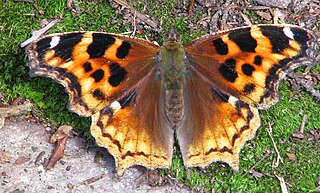| Nymphalini | |
|---|---|
 | |
| Aglais io | |
| Scientific classification | |
| Kingdom: | Animalia |
| Phylum: | Arthropoda |
| Class: | Insecta |
| Order: | Lepidoptera |
| Family: | Nymphalidae |
| Subfamily: | Nymphalinae |
| Tribe: | Nymphalini Rafinesque, 1815 [1] |
| Genera | |
Numerous, see text | |
Nymphalini is a tribe of nymphalid brush-footed butterflies. Common names include admirals , anglewings, commas , and tortoiseshells , but none of these is specific to one particular genus.
The name anglewing butterflies is an English translation of a Latin term papiliones angulati, [ Denis & Schiffermüller ], ([1775, 1776]). Based on an overall similarity in the angulate wing shape, a collective name: Papiliones angulati was employed for Papilio atalanta, P. antiopa, P. cardui, P. c-album, P. io, P. polychloros, P. urticae, P. xanthomelas, P. vaualbum, P. levana and P. prorsa. The term papiliones angulati is applied as a collective taxon name, which therefore needs no type species as specified in Article 42.3.1 of the International Code of Zoological Nomenclature. Papiliones angulati has thus been re-defined to apply only to a clade: Nymphalis sensu lato , and to specifically exclude Papilio atalanta [→ Vanessa ], P. cardui [→ Cynthia ], P. levana, and P. prorsa [→ Araschnia ].
This monophyletic group of nymphaline butterflies inhabiting the Northern Hemisphere are characterized by a jagged outline of their wings and the ability to survive the winter months as adults in an obligatory hibernal diapause, hiding in various shelters (e.g., crevices, hollows, cavities, even unheated buildings). The signature mark of all butterflies is the cryptic colour and maculation (spots) of the ventral (under) side of their wings, serving to conceal the hibernating butterfly against the substrate on which it rests.

